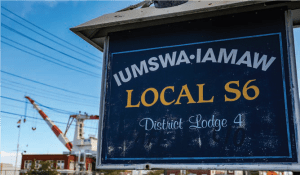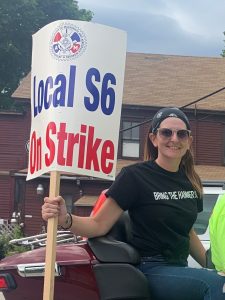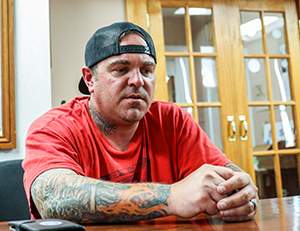There comes a time in life when people feel they have to take a stand for what they believe in. For the 4,300 members of IAM Local S6 in Bath, ME, that time was June 21, 2020 when they rejected the last, best and final offer from Bath Iron Works and voted to strike. The shipbuilders make Destroyers for the U.S. Navy, something that has been done in Bath, ME since before World War II.
The members of Local S6 take amazing pride in their work. “Bath Built is Best Built” is the shipyard’s slogan. The highly-skilled shipbuilders not only believe this to their core, but they were willing to sacrifice energy, time and money to keep it that way.
More than a year before the current contract was set to expire, it became apparent that Bath Iron Works was coming after the contract language that kept work in the bargaining unit.
“We were put on notice in 2019 that BIW was going to explore subcontracting,” said 18-year employee and Local S6 President Chris Wiers. “They felt they were falling behind on schedule and needed to go outside to get the work. We felt we had the manpower and skillsets, we just didn’t believe they were managing the workforce to it’s potential. We came to the table every day with what we believed were reasonable options. They just didn’t want to accept any of them.”
“Just prior to negotiations they actually brought in subcontractors to do some production work,” said IAM District 4 Business Representative Jay Wadleigh. “This was the first time since the early 80s that anyone has come in to do production work. When they brought them in, we knew it was going to be a tough negotiation.”
Wadleigh has plenty of experience in the shipyard and with BIW. He has 33 years seniority in the yard and has held many positions at the local, including president, before being hired by District 4 in 2016. He knows the importance of keeping work inside the bargaining unit.
“The sign on the gate says ‘Through these gates walk the best shipbuilders in the world’ and our slogan is ‘Bath Built is Best Built,’” said Wadleigh. “We take pride in our work and we will put it up against anyone else in the world. If you use out-of-state labor, ‘Bath Built is Best Built’ won’t mean anything anymore and it definitely won’t be true.”
The negotiating committee knew there was a fight brewing and needed to figure out a plan and strategy to be successful. They collectively decided success at the bargaining table would only be achieved through the strength and solidarity of the membership. Education and preparation would be key, so they went to work.
The negotiating committee attended a Negotiation Prep class at the IAM’s William W. Winpisinger Center in Hollywood, MD. The strike committee attended the class as well. Local leadership wanted to ensure that if they were forced to strike, the membership would be ready.
“When there is a good possibility of a work stoppage, it’s important to know what’s next if that does happen,” said Wadleigh.
“They gave us a lot of information that we needed,” said strike committee member and Shop Steward Levi Benner. “We paid attention, put everything in a binder and had a plan. When the votes came in that we were going on strike, we were ready to go.”
Membership education would play a large role in the success of the strike as well. As with many workforces around the country, there is an age gap in the membership of Local S6. With large gaps in seniority comes different wants and understanding of the necessity of certain contract language.
“They hired about 1,800 people in the past two years,” said Wiers. “So we were a little concerned that they didn’t have a deep rooted history in unionism and wouldn’t understand the need to fight the subcontracting. Boy were we wrong about that.”
With the company being well aware of the age and seniority of the membership, the negotiating committee expected BIW to tempt the younger workers with wage increases and bonuses while gutting the current subcontracting language.
“We focused on educating the younger members on the importance of seniority and subcontracting, and to look at the overall contract, not just the money,” said Wadleigh.
Wiers was impressed at how the membership responded.
“They stepped up,” said Wiers. “They saw the fight and recognized it, they educated themselves, asked questions and wanted to be involved. Our members really stuck to their guns and stood behind us as a negotiating committee, they learned and knew the facts. They were ready.”

Jami Bellefleur, an IAM Local S6 member for seven years, worked to rally and educate younger workers at BIW because she knew they would have a big impact on the contract vote and strike.
The more the membership learned, the more they became engaged in the process. Collective action in the yard brought attention to many young members who may never have gotten involved.
Jami Bellefleur, 34, is a second generation shipbuilder working in the paint shop and has worked at BIW for seven years. She was inspired after hearing about the action called “bringing the hammer down,” where the entire workforce hammers on toolboxes and other hard surfaces at a certain time of day to send a message of solidarity to management. Bellefleur took to social media to spread the message to her younger coworkers.
“I think bringing the hammer down got people to pay attention and ask questions when they normally wouldn’t have,” said Bellefleur. “They gained knowledge they necessarily didn’t have before. The day we started voting, we had so much information from the union. I think that helped my generation see what the future would hold if this would have passed. It made it clear we needed to step up and vote this down.”
All the work and preparation geared towards the younger members really hit its mark.
“At the very beginning, I wasn’t quite sure,” said two-year member Trinity Driscoll. “It’s my first time in a union, I wasn’t sure what to expect. When the vote got close and everyone was hammering down and we were having rallies, I really got the sense of family. Now, I don’t think I could ever work without a union, especially this one.”
The contract expired at midnight on June 22, 2020, and the 4,300 members of IAM Local S6 withheld their labor from BIW and went on strike. However, going on strike can be much easier than making it successful and getting something out of it.
The negotiating committee went right to work, tapping into all the resources available to them. They contacted many of the elected officials, including U.S. Reps Jared Golden and Chellie Pingree, Maine Senate President Troy Jackson, Maine House Speaker Sara Gideon, State Senator Eloise Vitelli and many others.
Congressman Golden has an extensive working history with Local S6 and was very vocal and instrumental in trying to get BIW back to the table and bargain for a fair contract.
“I got involved because I believe in these men and women,” said Golden. “I believe in what they are fighting for. I know they are fighting for the future of the yard and the young workers that are there today. I’ve never seen a union that was asking for too much or being greedy. Always asking for a fair deal and a safe work place with good benefits in return for the hard work they do and the skills they provide. I believe in unions. There is nothing I could throw myself into that might have a greater impact on economics for the working class people I represent.”
A few weeks into the strike, the local reached out for mediation assistance from the Federal Mediation and Conciliation Service (FMCS). At that time, FMCS felt both sides were still too far apart and polarized to get a deal.
Finally, after more than five weeks on strike, FMCS brought in a federal mediator to help both sides find common ground and broker a deal. A long week of 15 to 16 hour days ensued, and both sides were able to reach a tentative agreement the S6 Negotiating Committee could recommend to the membership. That agreement secured the subcontracting language and protected seniority that the members were fighting so hard to keep.

IAM Local S6 Strike Committee member Levi Benner was proud of the preparation and organization of the strike and the positive impact it had on the solidarity of the membership.
“We believe our subcontracting language is some of the best in the country, and we wanted to preserve that,” said Wadleigh. “As a compromise, we worked with the company and gave them a reprieve through the end of the year to try and catch up the schedule. The contract also reestablishes a union-management team to go out and fix any problems that are holding up production. We are confident the workers have the answers to getting these ships back on schedule. That means more work coming in, which means more workers and an economic shot in the arm for this community.”
After nine weeks on strike, the members of IAM Local S6 overwhelmingly ratified the new three-year agreement on August 23, 2020. They stood up and fought for their future and the contract they deserve.
Strike Committee member Benner believes the work they put in to prepare for a work stoppage had a big impact on the solidarity of the membership.
“When people came down here to do their picketing, anything they needed, we had ready for them,” said Benner. “Some people were looking for jobs, we had jobs. Some people needed food, we had food. Advice and assistance, we had people to help them with that. Any kind of help that was needed, we had ready and it was provided.
“It made us stronger for sure,” said Benner. “People get worried, but once they saw all the help they could get and that things were going to be okay, their confidence grew. They knew they could stay out for as long as it takes to get the language we deserve.”
IAM Leadership “Could Not Be More Proud”
Leadership, strength and solidary are needed in every successful contract negotiation, even more so when the core of the contract is being challenged. With a global pandemic added to the mix, what the membership was able to accomplish will be talked about in Bath, and around the IAM, for generations.
“IAM Local S6 has shown the world that together working people can stand up and win for themselves, their families and their communities,” said IAM International President Robert Martinez Jr. “This fight for dignity, justice and good Maine jobs will go down in the history books of the Machinists Union and all of organized labor. I could not be more proud of our IAM Local S6 membership and negotiating committee, District 4 representatives, Eastern Territory staff and everyone who stood with the IAM and the best shipbuilders in the world.”
“I’m so very proud of this membership and what they have been able to accomplish,” said Eastern Territory General Vice President Jimmy Conigliaro Sr. “When I stood on picket line with this group, I knew right then and there they were going to get what they were fighting for. Good contracts don’t come without hard work, stress and sacrifice. With the entire country watching, this group showed that with preparation, education and solidarity anything is possible.”
IAM Headquarters General Vice President Brian Bryant was proud of strength and solidarity the members of his local showed during the nine-week strike. Bryant was a pipefitter at BIW and the former Local S6 President.
“The leadership of the Local, the professionalism of the negotiating committee and the solidarity of our members has been remarkable and unwavering throughout these negotiations and strike,” said Bryant. “Each one was a major factor in successfully reaching a fair agreement with BIW.”
“This was a strike for the ages,” said IAM Grand Lodge Representative Dave Sullivan. “Everybody at every level of this union worked together and showed what we can do when we’re united. When you’re on the right side of history, the sacrifice pays off.”
What if We Didn’t Fight?
The best shipbuilders in the world who make the world’s best ships, have no doubt about what the future of Local S6 and BIW would be if they had accepted the last, best and final offer in June. They were fighting for the younger workers, the future generations of shipbuilders and the future of the Maine economy.
“If the last, best and final would have passed, I don’t think either the union or BIW would exist” said Bellefleur. “If we’re not building it, I don’t see a possibility of that shipyard being here.”
“If the membership had accepted the company’s first offer, this shipyard wouldn’t be here,” said Wiers. “The union would have been phased out, this wouldn’t be a shipyard and you would see a huge detriment to the community. If you take a place like this out of the Maine landscape, it would kill the Maine economy.”
Although there were many politicians and organizations who assisted in the positive outcome for Local S6 and BIW, Wiers believes solidarity stands out above all else.
“The membership was the biggest factor in this strike being successful,” said Wiers. “Every time we were at the table saying no to the company, we had 4,300 people in the yard saying it in unison. They were the foundation in which we stood on to fight.”
- AH
The post Local S6 Built is Best Built appeared first on IAMAW.
